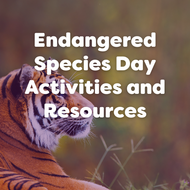Endangered Species Day Activities and Resources
Posted by EYR Team on 21st May 2021
read more

21st May marks Endangered Species Day – a day to highlight the threats thousands of different species of animals, insects, flowers and plants, and other creatures face. More than a whopping 37,000 species across the world face extinction. Now more than ever it's important we teach our littles one's empathy and the importance of caring for the world around them. We hope that learning about endangered species will instil a greater love and respect for animals, nature and any species they may encounter.
If you are an educator or a parent looking for ideas or activities you can do with your children, check out our suggestions below. We have carefully selected activities with EYFS, KS1 and KS2 in mind with our in-house Early Years specialist. Through these activities children will learn all about endangered species and animals, while strengthening their learning, knowledge and development in other areas of the EYFS and primary curriculum.
To get started with this exciting topic we suggest downloading our handy PDF which delves into why some species are endangered. We’ve also included the IUCN’s (International Union for Conservation of Nature) Red List Categories which defines the different classifications for determining whether a species is at high risk of global extinction.
Communication, Language and Reading
Early Years
Talk about what an endangered animal is – do the children know any? Can they think of any reasons why these animals are endangered? What can we do to help them?
Using our Penguin and Under the Sea Storytime Sets, can they make up their own stories?
KS1
After discussing what endangered animals are, ask the children to generate their own list. Can they remember the phonics and spellings that they have learnt so far? Read our set of books African Animals, four of the five animals are considered endangered. Can they answer questions about the animals and the stories they have read?
Read the attached poem. Can they recognise the animals and understand the words being used?
Research an endangered animal that they like (nurtures ICT skills). Can they explain why they like it and talk a bit more about it?
KS2
Can they list some subspecies of some endangered animals? (For example, Amur tiger, snow leopard, lowland gorilla, and pygmy hippopotamus).
Can they research and write a few paragraphs about one endangered animal? Where do they live? Why are they endangered? How many are left in the wild?
Read the attached poem. Can they make up your own poem using different endangered animals?
Go through the different endangered species classifications. What does each one mean and how are they different? Give at least one example for each classification.
Physical Education
Early Years
Stretch like a leopard on all fours, walk on two feet but mimic an elephant with its trunk by using one hand to swing about in front of your nose.
KS1
Frogs like the endangered big-eyed tree frog can jump up to 20 times their body length! How far can you jump? Jump forward ten times in a row and see how far you’ve jumped!
There are also many endangered plants and flowers in the world. Pretend you are a rare plant like the corpse flower blooming, which rarely does. Crouch down and curl up, very slowly stretching and standing up, then finally slowly open your arms as wide as you can until you are in ‘full bloom’.
KS2
Cheetahs can run at 60mph and cover 50m in 2 seconds! How fast can you run?
African wild dogs hunt in teams by chasing down their prey. Split into two teams – dogs and wildebeest. You must work together as a team to fan out and chase the others and together find one ‘wildebeest’ to catch. They usually go for the slowest prey and can run for 3 miles without stopping! Can each wildebeest evade capture by running as fast and as far they can?
Understanding the world
Early Years
What type of habitats do some animals and species live in? (For example, giraffe – savannah/open plains, gorilla – jungle, polar bears – Arctic (North Pole), jaguar – rainforests, coral reefs – oceans)
KS1
Can they name some of the countries some endangered animals are from and understand there are some animals only found in certain countries or continents? For example African Lion in Africa and Asiatic Lion in India.
KS2
Why are some animals endangered? What are the different threats they face and can they explain them? (Habitat loss, invasive species, pollution, poaching and overuse - HIPPO)
PSHE
Early Years, KS1 and KS2
What can be done to help save some endangered animals? Can they think of ways the human population can save them?
Creative
Early Years
Can they act out the different things some animals do? Big cats stalk prey and roar, giraffes bend over with legs spread to drink water, chimpanzees thump their chests, “chatter” and groom each other (can be done in pairs)
KS1
Listen to the song “Animals in Danger”. Can they sing along to the lyrics on the screen? Perhaps they could try humming if they can’t quite grasp the lyrics of the song. Can they play some percussion instruments or clap and dance in time with the music?
KS2
Ask children to create a poster for their favourite endangered animal with some facts and figures. Make it as eye-catching as possible and use the right colours for the animals.
Maths (Solving Problems)
Early Years
Make sure to download our Endangered Species Facts PDF to get stuck in with these maths problem-solving activities. Can they count how many lions are in the pride (10)? How many are male (2), female (3) and cubs (5)?
Can they put these animals in order of how heavy they are from lightest to heaviest – clouded leopard, rockhopper penguin, reindeer, elephant, blue whale?
KS1
Giraffes can grow to 6 metres tall. A wild horse is 1.5 metres tall on average. How many wild horses stood on top of each other would equal the height of a giraffe?
If a sea turtle lays 99 eggs, but once hatched only 14 of them make it to the sea safely, how many are unfortunately caught by birds hunting them?
KS2
It’s not all bad news for some species. The California Condor bird numbered just 27 in 1987. In 2016 this number was 270 in the wild and 450 in total. How many more times has the 1987 number multiplied by? And how many of the 450 are in captivity.
In 1982, the South China tiger population was estimated to be 200. Just five years later it was no more than 40. What is the percentage in which it declined?
We hope you enjoyed our activities and some of the ideas came in handy! You can learn more about Endangered Species Day on the official campaign website.

